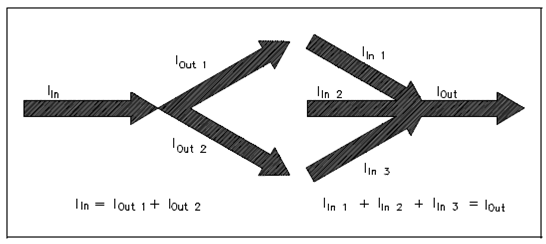Kirchhoff's Current Law:
Kirchhoff's second law is known as his current law and states: "the current arriving is equal to the current leaving at any junction point in a circuit." Thus, if 15 amperes of current arrives at a junction which has two paths leading away from it, 15 amperes will divide between the two branches, other than a total of 15 amperes have to leave the junction. We are already familiar along with Kirchhoff's current law from parallel circuits, which is, the sum of the branch currents is equal to the total current entering the branches, as well as the total current leaving the branches that display in the figure.

Figure: Illustration of Kirchhoff's Current Law
In equation form, Kirchhoff's current law may be expressed:
IIN - IOUT = 0 (2-16)
or
IIN = IOUT
Generally Kirchhoff's current law is not used through itself, but along with the voltage law, in solving a problem.